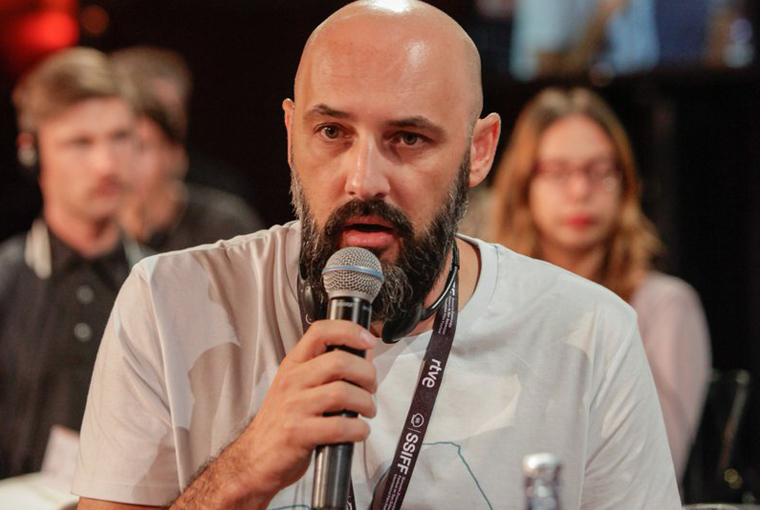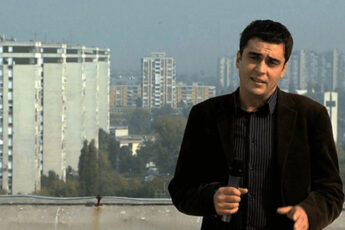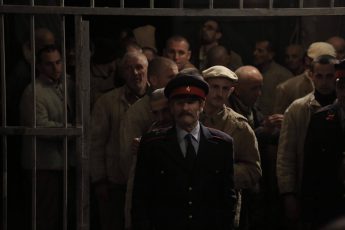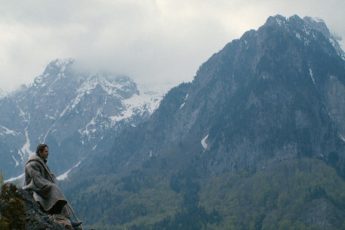
We met Kosovar director Ismet Sijarina at this year’s Crossing Europe film festival in Linz, where he presented his feature “Cold November”. The film is based on the filmmaker’s childhood recollections of the difficult years leading up to Yugoslavia’s violent disintegration. He speaks about the political situation in 1990s Kosovo, and about the motivation behind making “Cold November”.
How did you come to the topic of the film?
These are the memories from my childhood. I remember these years and the way in which we survived during the apartheid that was installed. Until 1989, Kosovo had all institutions and then everything was reestablished by the Serbian government. I remember the faces of my parents who came home after losing their jobs. These were terrible years and the international audience doesn’t know anything about it, because whenever we talk about Kosovo, it is about the war happening in 1998 and 1999. All films were mostly focused on these years as well as on the years after the war, but nobody wanted to treat the beginning of it, how everything started. I wanted to draw the attention of the global as well as the local audience to this. In these years we went through hell and we didn’t feel it, because I was a kid and then a teenager. But now, a more realistic and objective approach to the issue is possible. I wanted to bring out these years in which we didn’t live, but merely existed. We were only numbers and had no rights. It was the last apartheid that was established in Europe and hopefully it will never return.
Cold November also deals with the theme of resistance, the individual resisting against the masses. Can you speak a bit about that?
It was my second interest to treat the topic how we judge people for their decisions. It doesn’t matter what kind of decision people make, but sometimes they make a different decision and then we judge them without knowing the background of it. This happens a lot back home. People feel more comfortable to run after the mass, so that whatever happens to the majority can happen to you as well. Being a minority or being an individual is difficult. Whenever you’re an individual, everybody focuses on you and asks why you are not like everyone else, why you are different. This was an issue that I wanted to treat, because at that time 200 000 people were kicked out from their jobs, but there were very few people who decided to continue working for different reasons. And I thought that, since they were not conventional, focusing on these characters might produce a good story.
That brings us to your main character Fadili. He represents this minority of people who decided to continue working.
Yes, I wanted to place a character in between the fault lines. As I said, you are an individual, so you are endangered by all sides. My character must choose only between two wrong decisions, two wrong ways, and he is aware of that. He decides to choose the one that he considers to be the least bad one, but then he has to swallow everything from both sides. It was interesting to put a character in this position, because then you can treat both sides and the ways in which they treat him.
The viewer’s attention is immediately caught by the unusual aspect ratio of your film. Would you like to say more about the technical background?
Wherever I went, probably the first question was about the aspect issue, because you don’t see many films in 4:3. They asked me how I could still make a film in 4:3 today. I think that as a filmmaker, you have all the equipment, the camera, all these possibilities to make a film, but you don’t have to use all of it. You are supposed to see what fits the story. The whole film is shot with two lenses only. It’s a portrait film and I decided to reduce the size to limit the character’s space. The general audience just feels it, they don’t know how to describe it, but the critics really got it; they said that they felt trapped within this frame and were feeling what the character was feeling. That was the general idea of doing it in 4:3. Most of the film is shot in one-shot-scenes. I decided to work more with the actors and with the mise-en-scène, so that the actors have the freedom of movement and reaction.
In the post-screening Q&A, you explained how the dialogues were developed in close collaboration with the actors, sometimes quite spontaneously. What did this process look like?
When I started to write the script together with my co-writer Arian [Krasniqi], we already had about 25-30 pages and then started to make separate scenes and to build the whole story from there. I was planning to have a kind of realistic approach to the film. I was aware that all the people who were engaged in the project went through these experiences as children or maybe even as grown-ups. I thought that it’s not enough if only Arian and me write the script; so why not gather the experiences from all the people that went through it and survived? We knew that we cannot write the script together with 30 people, but at least we can make space for them. And then we decided to write the scenes and just rough dialogue lines, with only very little information about what is going to be discussed. Then we did rehearsals with the actors during the pre-production; the actors created their characters with us and based on these characters we started to write lines. And then, in the set again, when we did the rehearsals before the shooting, I wanted things to just happen.
An interesting stylistic device is the use of color. There is a clear separation between two color palettes for interior and exterior spaces. How is that related to the topic of your film?
At that time, it was forbidden to move or to go outside after 7pm. So we were isolated, like in a big cold prison. All these rules applied for Albanians only, not for Serbs. Serbs could go out, make noise, shoot with a gun, but as an Albanian it was not allowed to go out, so we stayed inside our houses. Can you imagine yourself being surrounded by your family and not having any rights to go out, and no technology? Then again, the atmosphere that we had in our homes at the time was very warm, we never hugged and loved each other more than we did then. Inside our houses it was very warm, although it was very cold, because the central heating was not working. The whole energy inside our houses was really good and that’s why we chose to have warm colors inside the houses. We decided to have blue, very cold colors outside and in the factories as well, where the environment is not friendly. When the Serbian colleague comes to visit in the house, it’s a warm atmosphere and discussion but whenever she is in the factory and in the office, it’s cold.
Were the demonstrations with the keys and the plates on the balconies really happening like this?
All of that was real, the ways in which they demonstrated on the balconies with the keys, the plates and the candles as well. The candles were there to remember the victims that were shot every single day. I remember that very well, setting up these candles when I was a child. We did that all the time with the plates, the whole family. If we did candles and keys one day, then on another day we chose candles and plates. Everything was arranged like that.
And how was this ritual developed?
It was springing up spontaneously. There was a young generation of intellectuals at that time which was very creative. They realized that they cannot go out, because if they go out and take part in demonstrations, they will be shot. There were tanks and military bases all over Pristina, police as well, so the only way to demonstrate was to stay on the balconies. It was around fifteen minutes doing all that stuff which was really fun and creative, and I still remember that noise.
Although the plot is set in a very particular context, Kosovo in 1989, it feels like a universal story that can be understood in different cultural contexts. How were the reactions towards your film?
When we applied to festivals, the film was accepted in San Sebastian and then everybody was running for it. Which was interesting, because the script had constantly been rejected, so I can say that as a script or as a project, this film is probably the most rejected project ever. When the festivals only saw the topic, they were hesitant, because they were expecting it to be a political film project that will take sides. I was convinced that if we had the chance to film this with a basic fund, many producers and festivals will run after it.
And in the end, it’s not a propaganda movie.
It’s really not. When we had the premier in San Sebastian, we were nervous how the audience will react, because they have political issues with the Basques and the Spanish government as well, but actually none of them discussed the film on a political level. It was treated as a social drama and as something that can happen everywhere. Nobody asked me a single question about politics, and we were very surprised. Only in Greece, in Thessaloniki, they started to ask political questions, but their questions were more related to their own experiences. Since they have seen very few films from Kosovo, they were looking forward to meeting a filmmaker from Kosovo to deal with the political issues. But somehow I always tried to escape these kinds of questions and dialogues with the audience, because I’m an artist and not a politician. And I’m not interested in being one. As you have seen in the film, I haven’t brought any conclusion to it, because I have no right to do that. Artists raise questions, bring out the project and then the people can judge and decide whether this is wrong or right. Our mission is to make people talk about the film. I made a fiction film and it’s a work of art. It’s not easy to make this kind of stories which are not conventional and do not satisfy the appetites of everyone. I was not interested in bringing a conclusion or making a propaganda film. I wanted to attract a worldwide audience.
Thank you for the interview.




Leave a Comment